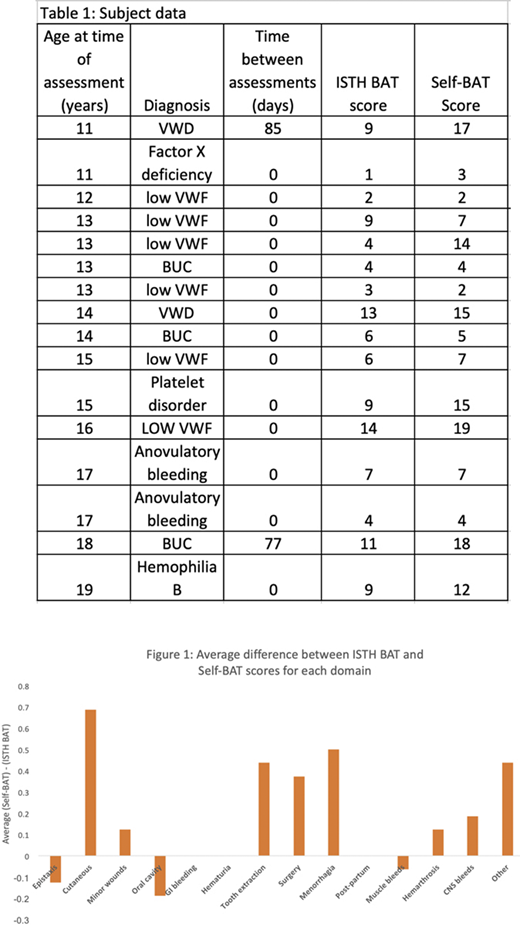INTRODUCTION
Women with inherited bleeding disorders of all severities often present with heavy menstrual bleeding (HMB) during adolescence. The International Society of Thrombosis and Haemostasis Bleeding Assessment Tool (ISTH BAT) is a clinician-administered instrument that has become part of the standard initial assessment of individuals with possible bleeding diatheses and for which pediatric normal ranges have been established (Elbatarny, Haemophilila 2014). The Self-BAT is an instrument that has gained popularity due to its ability to be performed independently by the patient either on paper or electronically. While favorable intraclass correlation has been demonstrated between these tools for individuals >18 years of age, the Self-BAT has not been validated in an adolescent population (Punt, HT Open 2019). We therefore sought to compare the results of the physician directed ISTH-BAT with the Self-BAT in a population of biological females <20 years of age.
METHODS
Eligible subjects included biological females under 20 years of age seen at the University of Colorado's Hemophilia and Thrombosis Center's adolescent bleeding disorder (Spots and Dots) clinic for evaluation of HMB and assessment of either a known or suspected bleeding diathesis. Subjects were administered both an ISTH BAT and Self-BAT within a three-month period. All ISTH BATs were performed and scored by the same hematologist. Each subject used an iPad to enter data for the self-BAT which was collected into REDCap and scored by the same hematologist. Age at the time of assessment and underlying bleeding disorder diagnosis or etiology for HMB were also recorded. Descriptive statistics and Pearson's Correlation coefficient were used to compare the outcomes between the ISTH BAT and the Self-BAT.
RESULTS
Sixteen biological females met inclusion criteria and were included in our analysis (Table 1). Patients ranged in age from 11 to 19 years. Over 55% of subjects scored higher on the self-BAT than the ISTH BAT. On average, the self-BAT resulted in scores that were 2.5 points higher (range = -2 to 10). Subjects with identifiable inherited bleeding disorders and low VWF on average scored 3.09 points higher on the self-BAT while those with bleeding of unknown cause (BUC) or anovulatory bleeding scored on average 1.2 points higher. The difference in score would have resulted in a different classification in 2 patients (12.5%). The cutaneous (bruising) domain accounted for the largest contribution to higher self-BAT scores, followed by heavy menstrual bleeding (Figure 1). There did not appear to be a clear association between younger age and a greater difference between the two scores (r = 0.25, p = 0.36), though the number of available subjects did not allow for a powered assessment of this.
CONCLUSIONS
Based on the results of this study, we feel additional investigation is warranted to validate the tools used to screen for and confirm inherited bleeding disorders in the adolescent population of biological females with heavy menstrual bleeding. The Self-BAT may not be an optimal means of assessment in individuals under the age of 20 years and may overestimate clinical bleeding history.
No relevant conflicts of interest to declare.
Author notes
Asterisk with author names denotes non-ASH members.


